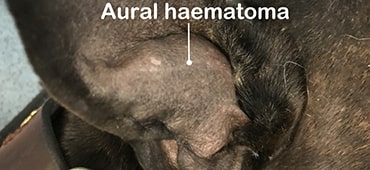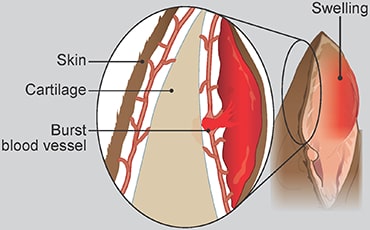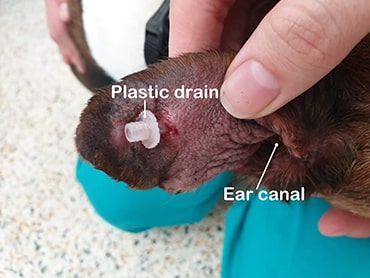Aural haematoma (swollen ear flap) in a dog
Overview
- An aural haematoma is a blood filled swelling inside the ear flap.
- The swelling is usually soft, hot to touch, and causes the ear to droop.
- Most aural haematomas develop because of an underlying problem such as an ear infection, skin problem or ear mites.
- Fortunately, once the underlying cause has been cured, most aural haematomas are fairly straightforward to treat.
- Always book an appointment with your vet if your dog develops an aural haematoma – never attempt to treat it at home.
What is/what causes an aural haematoma?
An aural haematoma is a pocket full of blood that develops if a blood vessel bursts inside the earflap. Aural haematomas most commonly develop when a dog repeatedly shakes their head or scratches their ear because of an underlying problem such as an ear infection, ear mites or itchy skin. Aural haematomas occasionally develop after an injury or knock to the ear, but this is much less common.

An aural haematoma forms when a blood vessel bursts in the ear.
Symptoms
Aural haematomas tend to cause:
- A swollen, droopy earflap (that develops very suddenly)
- Redness, heat and pain
- Head shaking
- Ear scratching
- Head tilt (holding the head to one side)

An aural haematoma is a blood blister in the earflap
Treatment
Your dog is likely to need their ear drained, pain relief, and treatment for the underlying cause.
Draining the swelling – some small, painless aural haematomas can be left to heal by themselves, but most are painful and need to be drained. Some can be drained with a syringe and needle, but if the swelling comes back (which is very common), your vet may advise surgery to open the earflap, remove the blood, and leave a drainage hole to stop it refilling.
Pain relief – aural haematomas are often very uncomfortable so it’s likely that your dog will benefit from pain relief.
Treatment for the underlying cause – your vet will also prescribe treatment for what caused your dog’s aural haematoma to form in the first place. This could be antibiotics for an ear infection, treatment for ear mites, or perhaps anti-itch medication for a skin problem.

Ideally this drain will stay in place for a few days to remove new blood
Homecare
A large part of your dog’s recovery is the care you give them at home. You will need to:
- Keep their ear clean and protected while it heals – the best way to do this is by using a buster collar (head cone), which should be washed regularly and left on until your dog’s ear has completely healed.
- Regularly clean your dog’s earflap using warm salty water – be very gentle so not to disturb healing.
- Give all prescribed medication (you may find our medication timetable helpful)
- Call your vet if you notice any unexpected symptoms. It’s normal for an aural haematoma to leak a small amount of blood for a few days after being drained. However, you should call for advice if you are worried that your dog’s ear is bleeding more than expected, or is becoming increasingly painful, red or swollen.
Cost
Treating a simple aural haematoma is likely to be relatively inexpensive, but it’s important to remember that most are caused by an underlying cause such as an ear infection, or skin problem, which will also need treatment. If your dog requires ongoing medication, check-ups, or surgery, the cost of treatment will rise. Always speak to your vet openly about the treatment costs and your finances.
Consider taking out dog insurance as soon as you bring your dog home, before any signs of illness start. This will give you peace of mind that you have some financial support if they ever become unwell.
FAQs
Can an aural haematoma heal itself?
Some small aural haematoma swellings can heal by themselves, however, there is nearly always a painful underlying cause that needs treatment (such an ear infection). It’s also important to be aware that aural haematomas left to heal by themselves often result in a scarred, thickened, crinkly earflap (just like a rugby player with ‘cauliflower ear’).
Can I drain my dog’s haematoma?
No, never try to drain an aural haematoma at home – you could cause further injury or infection.
Published: August 2020
Did you find this page useful?
Tell us more
Please note, our vets and nurses are unable to respond to questions via this form. If you are concerned about your pet’s health, please contact your vet directly.
Thank you for your feedback
Want to hear more about PDSA and get pet care tips from our vet experts?
Sign up to our e-newsletter
Written by vets and vet nurses. This advice is for UK pets only. Illustrations by Samantha Elmhurst.

